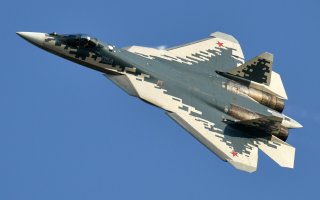These 5 Features Make Russia’s Su-57 Stealth Fighter a True Threat
The Su-57 threatens high-value air targets, among other things, with the IMA BK integrated avionics package that tracks enemy units and proposes the most effective engagement options to the pilot.
Here's What You Need to Know: The Su-57 succeeds in acting as a counter to the F-35.
Few contemporary aircraft have invited the avalanche of controversy sustained by Russia’s Sukhoi Su-57 over the past decade. But despite being repeatedly declared a dead project, the first serial Su-57 units are here—and they bring a host of advanced capabilities that can credibly threaten North Atlantic Treaty Organization (NATO) assets.
Here are five of the Su-57’s top features.
Aerodynamics
Russia’s United Aircraft Corporation (UAC) designed the Su-57 as a class-leading air superiority platform; by all early indications, the UAC succeeded in spades. The Su-57 can more than give Lockheed Martin’s F-35 a run for its money in pure aerodynamics, boasting a speed of up to 2 Mach without the use of afterburners and subsonic range of up to 3,500 km. It trades stealth performance for thrust-vectoring, granting a level of supermaneuverability that translates into excellent performance in dogfighting scenarios. As previously noted by The National Interest, the Su-57 isn’t so much a dedicated stealth fighter as it is an anti-stealth fighter—a purpose-built machine that leverages its raw speed, maneuverability, and weapon acquisition tools to detect, engage, and neutralize high priority aerial targets with brutal efficiency.
Firepower
The Su-57 primarily carries a potent arsenal of air-to-air missiles. An advanced evolution of Russia’s early 2000’s medium-range R-77, the K-77M beyond visual range (BVR) radar-guided missiles bring an active electronically-scanned array radar seeker and an impressive engagement range of just over 150 km. The short-range slot is capably filled by two K-74M2 infrared guided missiles. The Su-57 will reportedly support Russia’s upcoming R-37M long-range hypersonic missiles. Despite being intended largely for air-to-air missions, the Su-57 also boasts limited ground strike capability with the Kh-38 tactical ground missile as well as a range of guided bombs from the KAB family. Lastly, the Su-57 may also carry a version of Russia’s nuclear-capable, hypersonic Kh-47M2 Kinzhal missile.
Cost
The Kremlin has made major strides in recent years to drive down the Su-57’s cost, making it easier to mass-produce and allowing Russia’s defense sector to export it at a more competitive price. At a rough projected per-model cost of just $40 million, the Su-57 is markedly more advanced but seemingly no more expensive (at least, not significantly so) than its highly capable Su-35 predecessor.
Countermeasures
The Su-57 threatens high-value air targets, among other things, with the IMA BK integrated avionics package that tracks enemy units and proposes the most effective engagement options to the pilot. The fighter boasts a well-implemented avionics suite, including side-mounted electronically scanned array (AESA) radars for added situational awareness and “beaming” countermeasures. In keeping with its anti-stealth mission, the Su-57 offers the 101KS Infrared Search and Track system to facilitate detecting and engaging stealthy aircraft at long ranges.
Okhotnik-B
In the summer of 2019, Russia’s Defense Ministry released a video depicting Sukhoi’s upcoming Okhotnik-B drone flying alongside a Su-57. It is highly likely that the drone is being developed as a kind of “loyal wingman” for the Su-57, augmenting the fighter’s performance with datalink and reconnaissance support. Okhotnik also appears to have some limited offensive capabilities, potentially allowing it to strike in places deemed too high-risk for its accompanying Su-57. It has yet to be revealed how exactly the drone is controlled, and to what extent it can operate autonomously.
Mark Episkopos is a national security reporter for the National Interest.
This article first appeared earlier this month.
Image: Flickr

